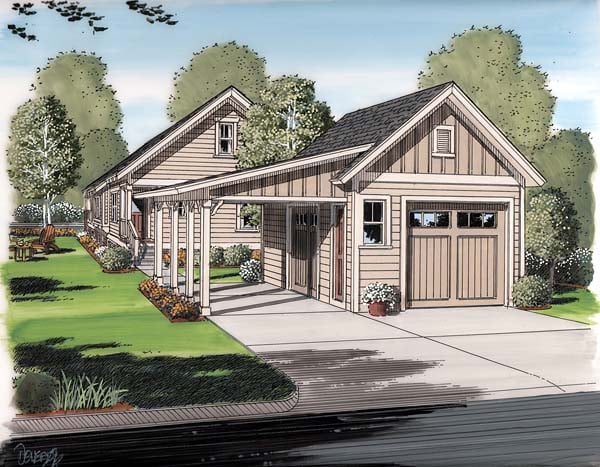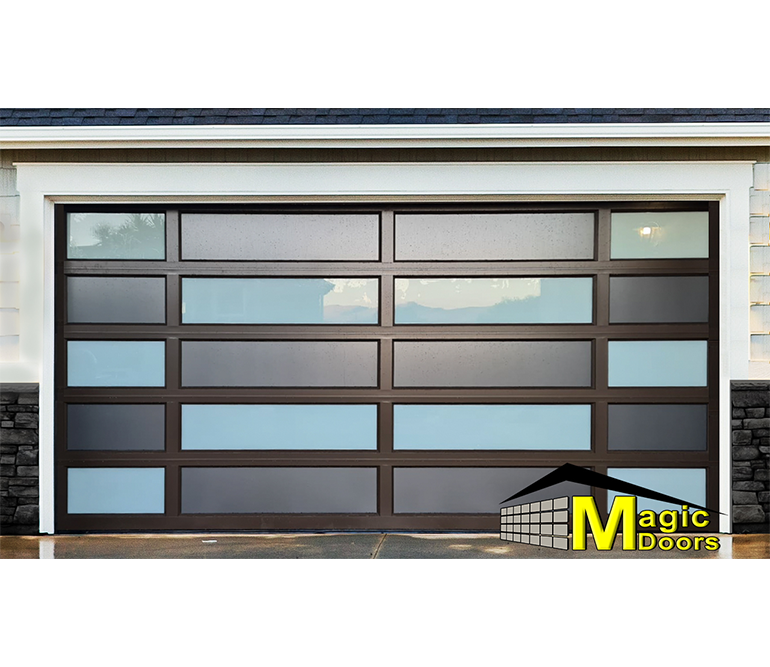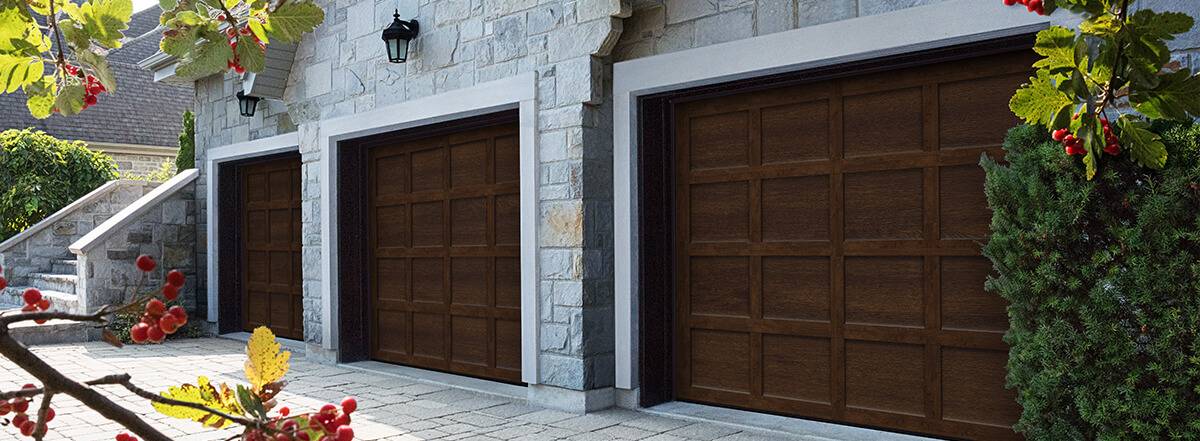
It does not matter if your garage door is being replaced or installed, it's important to do the job correctly. It's a labor-intensive task. The door is also heavy and dangerous. So you need to ensure you are doing it safely and correctly.
A new garage door, or replacement of an existing one, can make a significant addition to your house and increase its worth. The key is choosing the right garage door for your needs and budget.
When the garage door is too old, or if it is damaged from years of use, it may need to be replaced completely. Mallory Micetich, Angi's home care expert, suggests replacing the garage door if there are signs of wear like rust and peeling paint.
With proper maintenance, some garage doors can last decades. However, if the springs or tracks are wearing out, or if you notice any other problems, it is best to have a professional inspect and repair the garage door.

Your garage door can make or break the appearance of your home. It can look unattractive and rundown if your door is damaged. You may also have to pay a higher premium for insurance because your garage doors are not as secure.
The cost of installation will vary depending on what type door you choose. The cost of single, swing-out, or sliding doors can vary between $400 and $1,000.
Fixing the doors
Garage doors that don't open and close correctly can be frustrating. It can be frustrating to open or close a garage door if the rollers become stuck or loose, or if the track isn’t properly positioned or the springs have worn out. Although it is usually straightforward to fix garage doors, it can be difficult to move them.
If the door doesn't close, it could be due to a bad sensor or a damaged spring. To ensure that safety sensors are working properly and pointed at each other, and not obstructed by toys or flower pots, it is essential to inspect them regularly.
After you've identified the problem with the safety sensors use a mild cleaner to clean them. If the safety sensors turn a yellowish-rusty color, they need to be replaced.

Finally, tighten the hardware so that the rollers stay in place. This includes making sure the lag screws have been tightened and that the slide bolts attached to the roller wheels are secure.
Attach the lifting cord that runs along the garage door to end of extension spring. Run the looped cable along the extension spring's end. Feed it through the pulley at its end. Attach the other end of cable to a peg on the bottom of your track. Assist an assistant to raise the garage doors about halfway up.
FAQ
What is included in a full kitchen remodel?
A complete kitchen remodel involves more than just replacing a sink and faucet. There are also cabinets, countertops, appliances, lighting fixtures, flooring, plumbing fixtures, and much more.
Homeowners can remodel their kitchens completely without needing to do major work. This allows the homeowner to update their kitchens without having to demolish any existing structures, making it easier for the contractor as well.
Renovating a kitchen can involve a range of services including plumbing, heating and cooling, painting, and even drywall installation. Complete kitchen remodeling may require multiple contractors, depending on how extensive the renovation is.
A team of professionals is the best way to ensure that a kitchen remodel runs smoothly. Small issues can lead to delays when there are many moving parts involved in a kitchen remodel. You should plan ahead and prepare a backup plan for any unexpected situations if you decide to DIY.
Why remodel my house when I could buy a new home?
Although houses are getting cheaper each year, you still have to pay the same amount for the same square footage. You will pay more for the extra square footage, even though you might get more bang for you buck.
A house that isn't in constant maintenance costs less.
Remodeling can save you thousands over buying a new house.
By remodeling your current home, you can create a unique space that suits your lifestyle. You can make your home more comfortable for you and your family.
Which order should you renovate the house?
First, the roof. The second is the plumbing. Third, the wiring. Fourth, walls. Fifth, the floors. Sixth, the windows. Seventh, the doors. Eighth is the kitchen. Ninth, bathrooms. Tenth, the garage.
Once you've completed these steps, you can finally get to the attic.
It is possible to hire someone who knows how to renovate your house. Renovating your own house takes time, effort, and patience. You will also need to spend money. You don't need to put in the effort or pay the money.
Renovations aren’t always inexpensive, but they can make your life easier and save you money in the long term. It's also a way to make your life more pleasant.
How do I determine if my house requires a renovation or remodel?
First, check to see whether your home was updated in recent years. A renovation may be a good idea if there have been no updates for several years. A remodel may be a better option if your house looks like new.
Second, make sure to inspect the state of your home. A renovation is recommended if you find holes in your drywall, peeling wallpaper, or cracked tiles. However, if your home looks great, then maybe it's time to consider a remodel.
You should also consider the overall condition of your house. Does it have a sound structure? Do the rooms look good? Are the floors spotless? These questions are critical when deciding what type of renovation you should do.
How much would it cost to gut a home vs. how much it cost to build a new one?
Gutting a home involves removing everything within a building including walls and floors, ceilings as well as plumbing, electrical wiring, appliances, fixtures, and other fittings. It's usually done when you're moving into a new place and want to make some changes before you move in. Due to so many factors involved in the process of gutting a property, it can be very costly. Depending on what job you do, the average cost for gutting a house is $10,000 to $20,000
Building a home means that a builder constructs a house piece by piece, then adds windows, doors, cabinets and countertops to it. This is typically done after purchasing lots and lots of lands. Building a home usually costs less than gutting and can cost between $15,000 and $30,000.
When it comes down to it, it depends on what you want to do with the space. If you want to gut a home, you'll probably need to spend more because you'll be starting over. But if your goal is to build a house, you won't need to disassemble everything and redo everything. You can build it the way you want it instead of waiting for someone else to come in and tear everything up.
Do you think it is cheaper to remodel a kitchen or a bathroom?
Remodeling a kitchen or bathroom is a costly undertaking. It might be more cost-effective to upgrade your home than you think, given how much you spend each month on energy bills.
It is possible to save thousands every year with a simple upgrade. A few small changes, such adding insulation to walls or ceilings, can cut down on heating and cooling costs. Even a modest addition can improve comfort and increase resale value.
Remember to choose durable and easy-to maintain products when you are planning your renovations. The durability and ease of maintenance that porcelain tile and stainless steel appliances offer over vinyl and laminate countertops is why solid wood flooring and porcelain tile are so much better.
You might find that upgrading to newer fixtures can cut down on utility costs. Installing low-flow faucets or showerheads can cut water use by up to 50%. By replacing inefficient lighting with compact fluorescent lamps, you can reduce electricity consumption up to 75%.
Statistics
- According to a survey of renovations in the top 50 U.S. metro cities by Houzz, people spend $15,000 on average per renovation project. (rocketmortgage.com)
- 5%Roof2 – 4%Standard Bedroom1 – 3% (rocketmortgage.com)
- About 33 percent of people report renovating their primary bedroom to increase livability and overall function. (rocketmortgage.com)
- 57%Low-end average cost: $26,214Additional home value: $18,927Return on investment: (rocketmortgage.com)
- 55%Universal average cost: $38,813Additional home value: $22,475Return on investment: 58%Mid-range average cost: $24,424Additional home value: $14,671Return on investment: (rocketmortgage.com)
External Links
How To
How can you plan a bathroom within a budget?
The most important thing about any remodeling project is to make sure you can afford it. It is impossible to expect to pay it off later if it is not possible for you now.
It is important to plan carefully and understand the costs involved in a bathroom renovation. Bathroom remodeling can be very expensive. There are many factors that influence the cost.
Labor is the largest expense. The size of the job, as well as whether the contractor is a professional or a DIYer, will impact the labor costs. Professional contractors are usually more expensive than DIYers because they have the experience and expertise.
Materials are another major expense. Prices per square foot can vary depending upon the type of material.
Finally, there is the cost of energy. This includes both your electricity and gas bills. Peak demand is when energy costs are most high.
The time taken to complete the project is another factor to consider. Bathroom renovations are usually a time-consuming project that requires patience and patience. Some projects can take weeks, while others can take many months.
Other than these three main categories, smaller items such paint, wallpaper, and flooring can add to the project’s overall cost.
Here are some tips to help you choose the right approach for your bathroom remodeling project.
-
Determine your Budget - Before you begin any remodeling project, it is important to determine what you can afford. It doesn't matter if you think you can afford it or not. Setting a realistic budget is key to knowing where you stand financially.
-
Plan ahead - When possible, schedule your bathroom remodel during the off-season. Lower energy usage in winter means you'll save money on heating or cooling. Consider scheduling your remodel for nighttime when there are fewer people using the bathroom.
-
Shopping around - Once you've established your budget, start looking at potential vendors. You have many options, including local shops, online retailers and even family members who are willing to collaborate on your project.
-
Select an Estimator - After you have identified potential vendors, contact each one to obtain estimates. In order to ensure that you get competitive pricing, it is important to obtain multiple quotes.
-
Get Multiple Estimates. After you receive your initial estimates, it is important to compare them with each other to determine which vendor has the lowest price. Once you have chosen the vendor you want, it is time to ask them for a written estimate.
-
You should include all costs in your estimate. Specific about any permits, taxes, fees, or other applicable costs in your locality.
-
You shouldn't overlook small details. When you plan your bathroom remodel, don't forget the important details. Are you looking for a new toilet, or do you just need one? Is there room for a shower curtain rod? These changes could easily increase the project cost.
-
Consider insurance - Your bathroom remodel will have a significant impact on your insurance coverage. You could end up paying more if you don't.
-
Hire a Professional. You might be able do the job yourself but it's much more enjoyable to have someone else do it.